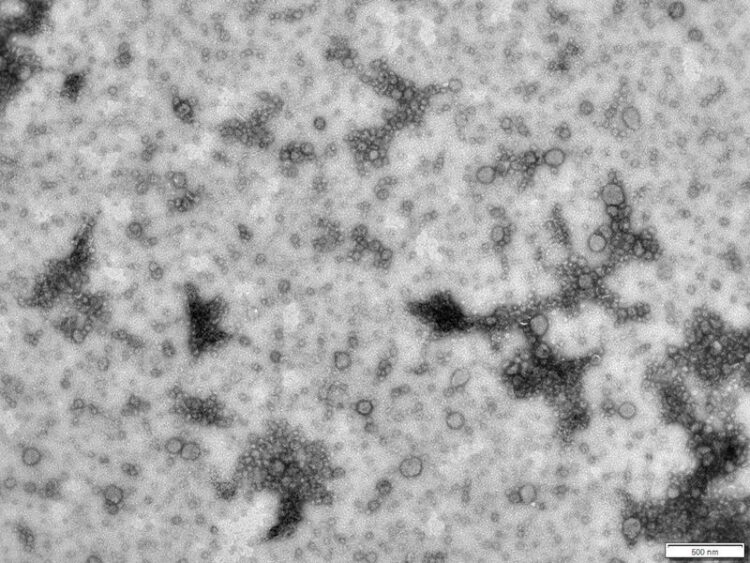Microbial comics

Extracellular vesicles of the haloarchaeon Haloferax volcanii, made visible with an electron microscope. The scale bar measures 500 nm.
(c) S. Erdmann / Max Planck Institute for Marine Microbiology
RNA as a common language, presented in extracellular speech-bubbles.
Decoding the conversations between microbes of hypersaline environments reveals deep insights into the origins of complex life.
Single-celled organisms, such as bacteria and archaea, have developed many ways to communicate with each other. For example, they might use tiny so-called extracellular vesicles (EVs) – membrane-enveloped packages smaller than 200nm in diameter (0.0002mm). The organisms produce them by budding from their membrane into the surrounding space. These EVs can contain a variety of molecules such as enzymes, nutrients, RNA and even fragments of DNA. Though it is suspected that they play a key role in microbial communities, little is known about their function or how they are produced.
Speech balloons for RNA talk
In a study now published in the journal PNAS, Susanne Erdmann with her team at the Max Planck Institute for Marine Microbiology and collaborators from other institutions in Germany and Australia (see below), investigated EVs from microbes that thrive in extremely salty environments such as the Dead Sea, known as halophilic archaea or haloarchaea. They found that their EVs traffic RNA – nucleic acids that play a central role in protein synthesis and gene regulation – between cells. “Obviously, EVs can act as an RNA communication system between haloarchaea”, Erdmann explains. In particular, the EVs transported specific RNAs with the potential to regulate processes in a receiving cell. “We think that this represents a communication mechanism to regulate gene expression across a whole microbial population. One could say, RNA is their common language, and the EV is the speech balloon.”
A GTPase known from eukaryotic cells
The team around Erdmann also investigated how the haloarchaea produce these EVs. “We found a small GTPase – a class of enzymes serving as molecular switches or timers in many fundamental cellular processes – that was very similar to a GTPase in more complex cells”, reports first-author Joshua Mills, who conducted the study as party of his doctoral thesis. “That is quite astonishing, as GTPase-dependent vesicle formation was previously thought to be only carried out within eukaryotic cells, between the membrane-bound intracellular compartments. Our finding suggests that components of eukaryotic intracellular vesicle trafficking could have evolved much earlier in evolutionary history than previously assumed.”
“Few studies have investigated the role of EVs within the archaeal domain to date”, Erdmann adds. “Here we show that EVs in salt-loving archaea can transport an RNA cargo and thus help cells communicate with each other. Also, we reveal exciting new insights into the evolutionary development of this communication strategy. Our study provides the basis for further studies into the evolutionary relationships between prokaryotic and eukaryotic vesicle formation and might help solving the puzzle of the evolution of the eukaryotic cell.”
Wissenschaftliche Ansprechpartner:
Dr. Susanne Erdmann
Max Planck Research Group Archaeal Virology
Max Planck Institute for Marine Microbiology, Bremen, Germany
Phone: +49 421 2028-7340
E-mail: serdmann@mpi-bremen.de
Originalpublikation:
Joshua Mills, L. Johanna Gebhard, Florence Schubotz, Anna Shevchenko, Daan R. Speth, Yan Liao, Iain G. Duggin, Anita Marchfelder, Susanne Erdmann (2024): Extracellular vesicle formation in Euryarchaeota is driven by a small GTPase. PNAS 121(10).
DOI: 10.1073/pnas.2311321121
Weitere Informationen:
https://www.mpi-bremen.de/en/Page6202.html
https://www.pnas.org/doi/10.1073/pnas.2311321121
Media Contact
All latest news from the category: Life Sciences and Chemistry
Articles and reports from the Life Sciences and chemistry area deal with applied and basic research into modern biology, chemistry and human medicine.
Valuable information can be found on a range of life sciences fields including bacteriology, biochemistry, bionics, bioinformatics, biophysics, biotechnology, genetics, geobotany, human biology, marine biology, microbiology, molecular biology, cellular biology, zoology, bioinorganic chemistry, microchemistry and environmental chemistry.
Newest articles
Faster, more energy-efficient way to manufacture an industrially important chemical
Zirconium combined with silicon nitride enhances the conversion of propane — present in natural gas — needed to create in-demand plastic, polypropylene. Polypropylene is a common type of plastic found…

Energy planning in Ghana as a role model for the world
Improving the resilience of energy systems in the Global South. What criteria should we use to better plan for resilient energy systems? How do socio-economic, technical and climate change related…

Artificial blood vessels could improve heart bypass outcomes
Artificial blood vessels could improve heart bypass outcomes. 3D-printed blood vessels, which closely mimic the properties of human veins, could transform the treatment of cardiovascular diseases. Strong, flexible, gel-like tubes…




















